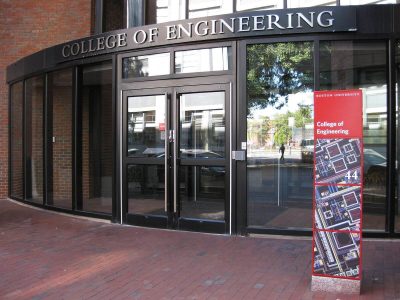
The first surgery performed with the assistance of robotic technology occurred in 1985. This surgery initiated an ongoing process in which researchers have since been developing new ways to improve robot-assisted medical treatment.
Sheila Russo, the founder of the Material Robotics Laboratory at Boston University, discussed the lab’s work to enhance the capabilities of medical technology through the use of robotic systems in a talk Feb. 8.
Russo, an assistant professor in BU’s Department of Mechanical Engineering, said the lab works with creating technology to make surgery less invasive through smaller, smarter and softer robots.
Russo founded the Materials Robotic Laboratory about a year ago with the primary goal of advancing medical technologies while also making them more accessible, she said in an interview.
“I have always wanted to build something that would make procedures easier to perform and more cost-effective,” Russo said.
Russo explained in the lecture that many medical instruments such as an endoscope, which is a tubular instrument that can show the internal organs of a patient’s body, can cost upward of $30,000. To make technologies more accessible to people, she said, they must be developed to be more cost-effective.
Another challenge is developing new instruments that are easy to learn to use, as surgeons go through years of extensive training in their fields and may not be eager to re-learn new methods of performing surgery, Russo explained in her lecture.
One of the projects in the Material Robotics Lab focuses on removing small tumors in the intestinal tract, according to Russo. She said when patients are first diagnosed with cancer, tumors may be so small they are difficult to operate on, so the patient will have to wait for it to grow enough to remove.
The Material Robotics Lab is currently working on developing a robotic platform to improve the ease of this process. Usually, the tumor area will have an injection inserted in order to raise the surface to allow it to be cut, Russo explained, but current research in the lab focuses on an expansion to the endoscope that will instead pull the tissue using vacuum suction.
This process minimizes the invasiveness of the surgery by getting rid of injections, thereby reducing the stress this process will put on the human body, Russo said.
Kirk Lewis, a doctorate student studying computational materials science in the College of Engineering, was the student host for the talk. He said he was enthusiastic about the innovative techniques that soft robotics offer.
“It was fascinating to see how soft robots have the ability to totally transform surgical procedures,” he said. “At the seminar, I got a good feel for how the requirements of soft robots might, in turn, drive the specifications of the materials used in their construction.”
The Material Robotics Lab is also researching the sensory output of instruments, such as the endoscope, Russo said. Current technology in minimally invasive surgery may consist of a surgeon operating a robot with a joystick.
However, endoscopes are not very flexible, and when turning corners in the body, they may bump tissue and cause bleeding, so the Material Robotics Lab is creating robots that can relay sensory information back to the surgeon as if it were hands-on, Russo said.
Russo’s lab is investigating how to develop robots out of soft materials. According to Russo, the inspiration for these robots is drawn from origami. The devices can be made of soft tissue, which can then be folded to interact with the human body in a gentler way in order to gather information and send it back to the surgeons.
The 10-millimeter actuators can also be developed to enter smaller and harder-to-reach places, such the bronchioles in the lungs, Russo explained.
Stephanie Woodman, a junior studying mechanical engineering in the College of Engineering, attended Friday’s talk and said it was refreshing to see research being applied like this.
“I came in not knowing much about soft robotics, and it was cool to see the kinds of things they’re trying out,” Woodman said. “A lot of times people in research don’t see reasonable applications.”
Kirk said he left the seminar feeling inspired about the work Russo and the Material Robotics Lab was doing.
“The origami-inspired robot designs of professor Russo and the new materials used in their construction,” he said, “are a fascinating and hugely beneficial research area.”


























































































































